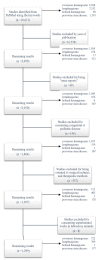Identifying erroneously used terms for vascular anomalies: A review of the English literature
- PMID: 37497531
- PMCID: PMC10367948
Identifying erroneously used terms for vascular anomalies: A review of the English literature
Abstract
Background: The classification of vascular anomalies includes terms of nomenclature that are not based on histogenesis resulting in confusion among health professionals of different specialties. Ongoing efforts to classify them properly have taken place. This literature review aimed to identify erroneous nomenclature of vascular anomalies and to investigate their continued use over the past four years after the last International Society for the Study of Vascular Anomalies (ISSVA) update.
Methods: Literature research was based on pertinent classifications (ISSVA, WHO) and books related to vascular anomalies and soft tissue pathology. After identifying twelve entities with confusing terminology, new research in the Pubmed database was conducted to verify their continued use in the last four years.
Results: The literature review highlighted terms referring to vascular malformations as neoplasms. In addition, terms used as equivalents represent entirely different entities. On the other hand, different terms to characterize the same entity were also recorded. Furthermore, regardless of the last ISSVA update in 2018, terms that are only descriptive or do not correspond to vascular anomaly histogenesis are consistently used.
Conclusion: Despite intensive efforts in the last decades for correct terminology and classification of vascular anomalies, modifications are still required. A common and broadly accepted scientific terminology should be applied, accurately representing histogenesis or pathogenesis, to obtain a common language among medical specialists, given that a multidisciplinary approach is crucial for managing vascular anomalies. HIPPOKRATIA 2022, 26 (4):126-130.
Keywords: Vascular tumors; pathology of vascular anomalies; terminology in vascular anomalies; vascular anomaly; vascular malformations.
Copyright 2022, Hippokratio General Hospital of Thessaloniki.
Conflict of interest statement
Authors declare no conflicts of interest.
Figures
References
-
- Rendón-Elías FG, Hernández-Sánchez M, Albores-Figueroa R, Montes-Tapia FF, Gómez-Danés LH. Congenital vascular malformations update. Medicina Universitaria. 2014;16:184–198.
-
- Heym KM, Masand PM, Margolin JF. How we approach the diagnosis of a vascular anomaly. Pediatr Blood Cancer. 2022;69 Suppl 3:e29802. - PubMed
-
- Mulliken JB, Glowacki J. Hemangiomas and vascular malformations in infants and children: a classification based on endothelial characteristics. Plast Reconstr Surg. 1982;69:412–422. - PubMed
-
- Enjolras O, Mulliken JB, Kozakewich HPW. Vascular Tumors and Tumor-Like Lesions. Mulliken JB, Burrows PE, Fishman SJ (eds). Mulliken and Young’s Vascular Anomalies: Hemangiomas and Malformations. 2nd Edition. Oxford University Press, New York. 2013:259–324.
Publication types
LinkOut - more resources
Full Text Sources
Miscellaneous

